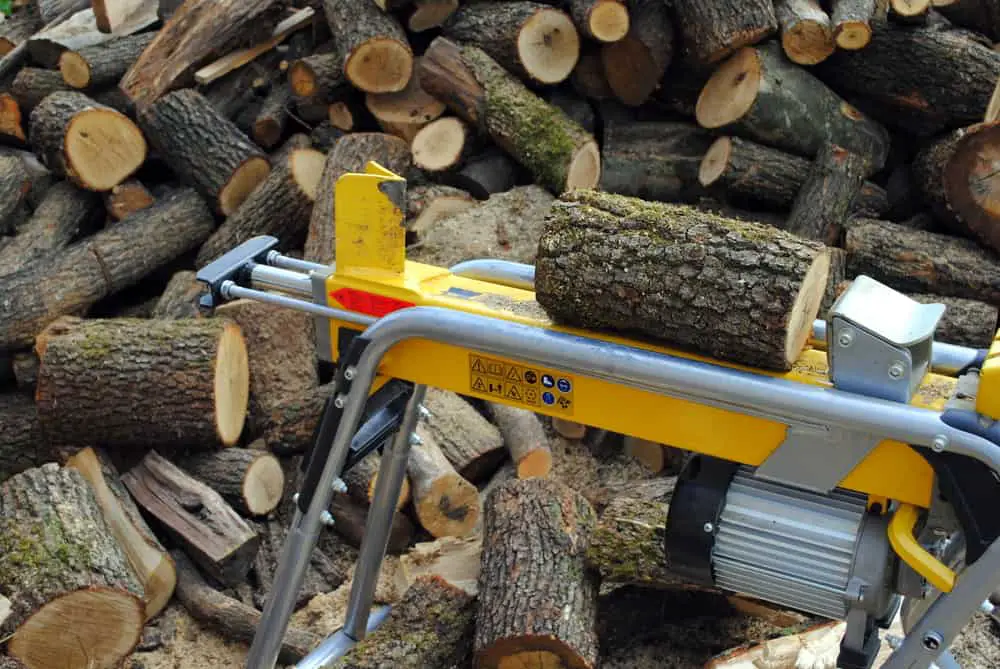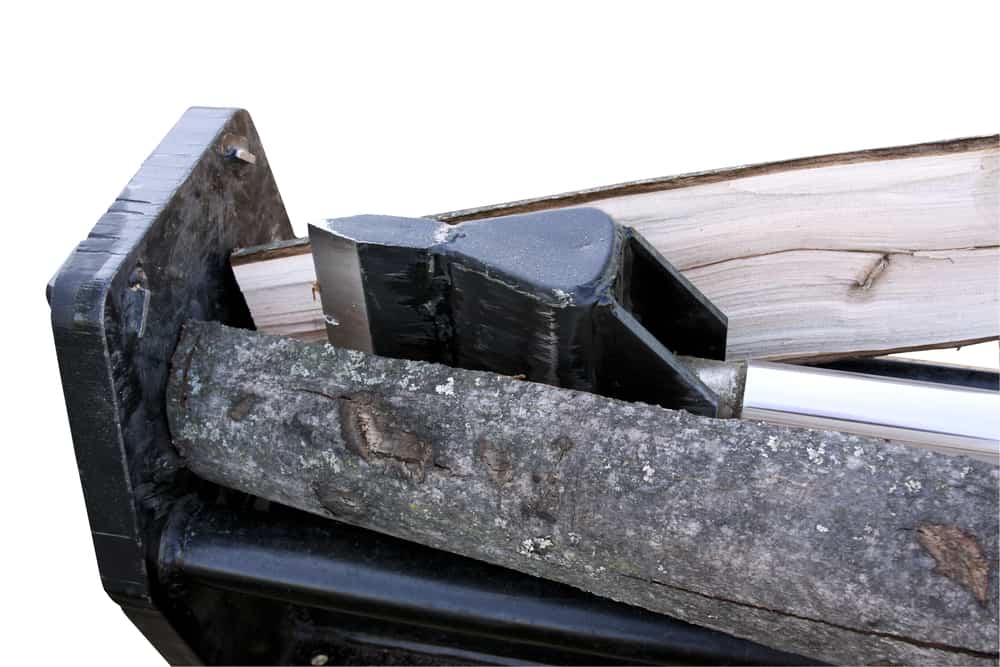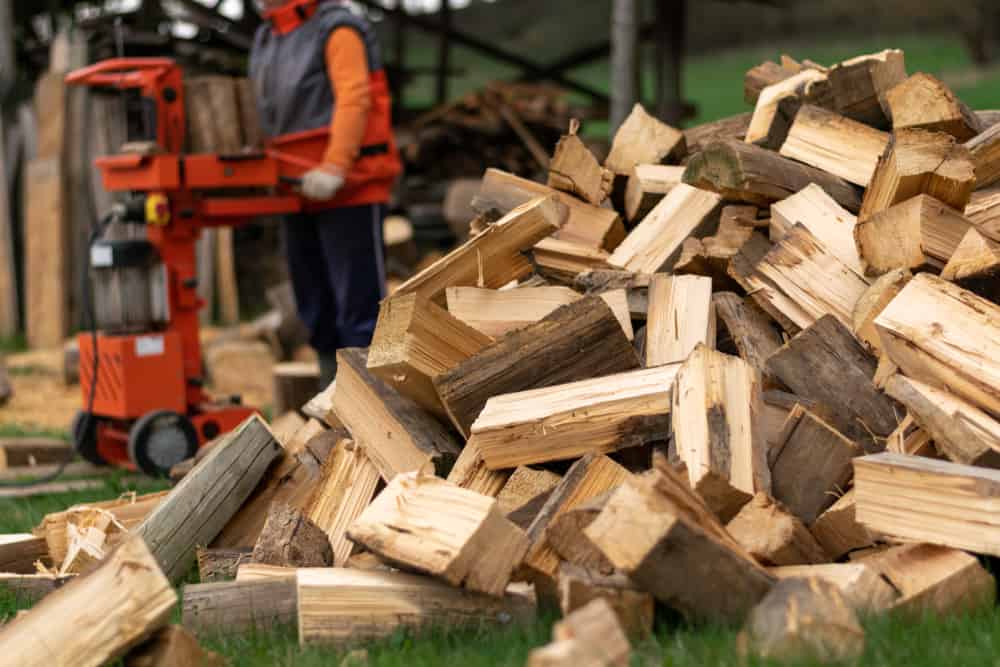Using a log splitter safely requires having the correct safety gear, familiarity with your log splitter, understanding the characteristics of the wood, and wearing suitable attire.
These are some basics, but we will get more specific in this article.
If you frequently engage in outdoor activities and reside in a heavily forested region, you likely dedicate a significant amount of time to converting those trees into usable timber.
This wood may serve as your primary source of heat and energy, or you might have a secondary income stream through its sale.
A log splitter is one of the best ways to ensure you have a sufficient supply of chopped wood.
This tool enables you to effectively divide large wooden logs into smaller fragments, allowing you to store them for future purposes.
Log splitters make sense for people who need to split a lot of wood, but they can be a bit intimidating to someone without any experience with them.
This article will discuss, in-depth, how to use a log splitter to split logs.

Related Reading: Log Splitter Ram Won’t Return? Here’s Why.
Table of Contents
Types of Log Splitters
Before going over how to use a log splitter, it’s important to understand which type you’ll be using. Log splitters come in three different forms:
- Manual
- Electric
- Gas
The best log splitter for you will vary based on your specific needs, capabilities, quantity of wood to be chopped, and desired method of chopping.
Let’s take a closer look at the differences.
Manual Log Splitters
Compared to other types of splitters, manual splitters necessitate greater exertion when splitting wood, despite their ease of use and storage capabilities. They can be operated by hand or foot.
For those on a tight budget who prefer not to use an axe for wood chopping or want to retain the physical aspect of splitting wood, this log splitter is a great choice.
Electric Log Splitters
Electric log splitters are perfect for individuals who desire efficient and speedy completion of tasks while ensuring your are using a log splitter safely.
The most commonly preferred log splitter type is the one we have at our shed. By investing some time in arranging your workspace, you can make significant progress in clearing your woodpile.
The demand for electric log splitters tends to rise with the increase in gas prices, as they offer a cost-effective alternative. One significant advantage of electric log splitters is their versatility, as they can be utilized both indoors and outdoors.
Gas-powered Log Splitters
Gas log cutters, available in the market, are ideal for tackling heavy-duty jobs such as the cutting of sizable logs.
However, it is important to note that despite their sturdy construction, these log splitters necessitate regular upkeep.
This post aims to provide a step-by-step guide on effectively utilizing a log splitter to maximize wood cutting efficiency and minimize the risk of avoidable injuries, as simply acquiring the equipment is insufficient.
Related Article: Log Splitters: Electric vs. Gas-Powered
Using a Log Splitter Safely
Log splitters, despite their various forms, exhibit many commonalities in their operational processes. Remember to adhere to these straightforward instructions when operating your log splitter in the future.
Step 1: Get the Necessary Equipment
The first thing you should do before turning on the log splitter is to get all the safety equipment you require for the task. They include the following:
- Goggles
- Boots or closed safety shoes
- Long pants
- Hand gloves (heavy-duty)
This type of gear can be conveniently purchased on Amazon in case you need some:
It’s also essential to eliminate items like rings, necklaces, watches, or other jewelry that can get caught in the splitter.
Step 2: Set the Log Splitter
Once you wear your protective attire, you can set up your wood-cutting machine. Select a location free of clutter but near the wood you’d like to split.
Ensure that the area is level and devoid of potholes to prevent potential accidents.
Next, position your splitter on a flat surface to maintain its stability while operating and feeding logs.
Once the log splitter is set up, consider placing cinder blocks or bricks around the wheels so the machine doesn’t start rolling when the wedge moves.

Setting up the log splitter on wet ground is a common mistake.
Regardless of the type of splitter you have, it will inevitably slip if placed on wet surfaces. Hence, it is important to ensure that the area is dry.
Step 3: Start Splitting the Logs
Since there are various types of log splitters, the instructions in this step will vary depending on the machine you have.
Manual Splitter
Manual splitters are very popular today thanks to their affordability and effectiveness. Here’s a step-by-step guide to using them:
- Start by tightening the jack.
- Place a log in the jack.
- Tighten the screws to ensure the log doesn’t move once you set up the cylinder that contains the wedge. If the screws aren’t tightened, the log will fall out before its cut or split partially.
- Once the log you intend to split is tightly secured, use your hand or the foot pedal to move the wedge into the piece of wood.
- Work the machine until your logs get cut. Don’t make the mistake of placing your fingers near the wedge when you begin cutting the wood.
- After splitting the log, pull the cylinder to its original position and undo the jack screws so the split wood can fall off the machine.
- Repeat the process until you cut all logs.
Powered Splitters
Electric and gas-powered log splitters operate similarly.
- If you are using a gas-powered splitter, check if the machine contains enough hydraulic oil and gas for the task. Switch the machine on once you confirm or refill the oil.
- Take a log and place it on the wedge, then activate the wedge to cut it. Depending on your machine, you may use a button or gear to activate the wedge.
- Reverse the handle once you cut the log so the wedge can be pulled back, and remove the pieces. Repeat the process.
Follow the same process when you are using an electric log splitter. The only difference is that your machine will be plugged into the power source.
Additional Tips For Using a Log Splitter Safely
Here are some extra tips that will make it easier for using a log splitter safely.
Understand Your Machine
Regardless of the log-splitting device you have, it is vital to familiarize yourself with the parts before using it, mainly if it is your first time.
You should know essential parts like the power button or exhaust pipe so you don’t get confused once you start operating the machine.
Split One Log at a Time
Splitting logs should only be done one at a time, regardless of whether you are using a manual or powered machine.
Attempting to cut multiple logs simultaneously can be hazardous and result in injuries.
Ensure that only one individual carries out the task at a time.
Refrain from the temptation of having someone load the machine while you operate it.
In the event of a minor problem or ineffective communication, there is a risk of injury to either or both individuals involved.
Know the Type of Wood
Before you start splitting the logs of wood in your yard, it is essential to know the kind of wood you’ll be cutting.
Ensure that you are familiar with the unique characteristics of various wood types, as they tend to exhibit different reactions.
It is important to be aware of what to anticipate from each type.
When working with logs that lack straight grain or have noticeable markings, it is advisable to be prepared for potential difficulties, as irregular splitting may occur.
The key to avoiding issues is sorting the logs before cutting them.

Wear the Right Clothing
Avoid the temptation to commence wood splitting in your regular attire, as you must resist this urge.
The ultimate objective is to prevent your elongated shirt from becoming entangled in the machinery.
Wearing comfortable, non-baggy attire is advised by experts.
Additionally, it is crucial to remember to wear shoes with non-skid soles to ensure leg protection.
Don’t wear sandals or be barefooted while operating the log splitter. Glasses or goggles are also required to ensure wood pieces don’t get to your eyes.
Prepare for Physical Activity
Splitting wood is not as easy as many believe, especially when using a manual splitter.
Therefore, ensure you get a good night’s sleep beforehand to stay alert while operating the log splitter.
If you find yourself feeling excessively tired or on the verge of dozing off while working, do not hesitate to turn off your machine.
Prioritize using a log splitter safely and prevent the risk of accidents by taking a break when needed.
It is best practice to only use a log splitter when alert.
Conclusion
Remember these recommendations when using a log splitter to ensure both safety and efficiency during your work. Incorporating these suggestions will simplify your tasks and yield successful results.
Glasses or goggles are necessary to protect your eyes from wood pieces.
Splitting wood manually is more challenging than many people think. Therefore, it’s important to get enough sleep before using a log splitter to stay alert.
If you feel excessively tired or about to fall asleep while operating the machine, turn it off.
Take breaks when necessary to prioritize safety and prevent accidents.
Always make sure you are fully alert when using a log splitter.
Remember these recommendations for safe and efficient log splitting.
Using a log splitter safely will safeguard you and anyone coming nearby while splitting logs.
You can enjoy lighting a fire with logs you split safely.
Enjoy living the outdoor life!!!

